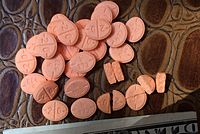| Generic or Trivial Name
|
Chemical Name
|
# of Subs
|
| Amphetamine |
α-Methyl-phenethylamine |
0
|
| Methamphetamine |
N-Methylamphetamine |
1
|
| Ethylamphetamine |
N-Ethylamphetamine |
1
|
| Propylamphetamine |
N-Propylamphetamine |
1
|
| Isopropylamphetamine |
N-iso-Propylamphetamine |
1
|
| Phentermine |
α-Methylamphetamine |
1
|
| Phenylpropanolamine (PPA) |
β-Hydroxyamphetamine, (1R,2S)- |
1
|
| Cathine |
β-Hydroxyamphetamine, (1S,2S)- |
1
|
| Cathinone |
β-Ketoamphetamine |
1
|
| Ortetamine |
2-Methylamphetamine |
1
|
| 2-Fluoroamphetamine (2-FA) |
2-Fluoroamphetamine |
1
|
| 3-Methylamphetamine (3-MA) |
3-Methylamphetamine |
1
|
| 2-Phenyl-3-aminobutane |
2-Phenyl-3-aminobutane |
1
|
| Tranylcypromine |
Trans-2-phenylcyclopropylamine |
|
| 3-Fluoroamphetamine (3-FA) |
3-Fluoroamphetamine |
1
|
| Norfenfluramine |
3-Trifluoromethylamphetamine |
1
|
| 4-Methylamphetamine (4-MA) |
4-Methylamphetamine |
1
|
| para-Methoxyamphetamine (PMA) |
4-Methoxyamphetamine |
1
|
| para-Ethoxyamphetamine |
4-Ethoxyamphetamine |
1
|
| 4-Methylthioamphetamine (4-MTA) |
4-Methylthioamphetamine |
1
|
| Norpholedrine (α-Me-TRA) |
4-Hydroxyamphetamine |
1
|
| para-Bromoamphetamine (PBA, 4-BA) |
4-Bromoamphetamine |
1
|
| para-Chloroamphetamine (PCA, 4-CA) |
4-Chloroamphetamine |
1
|
| para-Fluoroamphetamine (PFA, 4-FA, 4-FMP) |
4-Fluoroamphetamine |
1
|
| para-Iodoamphetamine (PIA, 4-IA) |
4-Iodoamphetamine |
1
|
| Clobenzorex |
N-(2-chlorobenzyl)-1-phenylpropan-2-amine |
1
|
| Dimethylamphetamine |
N,N-Dimethylamphetamine |
2
|
| Benzphetamine |
N-Benzyl-N-methylamphetamine |
2
|
| D-Deprenyl |
N-Methyl-N-propargylamphetamine, (S)- |
2
|
| Selegiline |
N-Methyl-N-propargylamphetamine, (R)- |
2
|
| Mephentermine |
N-Methyl-α-methylamphetamine |
2
|
| Phenpentermine |
α,β-Dimethylamphetamine |
2
|
| Ephedrine |
β-Hydroxy-N-methylamphetamine, (1R,2S)- |
2
|
| Pseudoephedrine (PSE) |
β-Hydroxy-N-methylamphetamine, (1S,2S)- |
2
|
| Methcathinone |
β-Keto-N-methylamphetamine |
2
|
| Ethcathinone |
β-Keto-N-ethylamphetamine |
2
|
| Clortermine |
2-Chloro-α-methylamphetamine |
2
|
| Methoxymethylamphetamine (MMA) |
3-Methoxy-4-methylamphetamine |
2
|
| Fenfluramine |
3-Trifluoromethyl-N-ethylamphetamine |
2
|
| Dexfenfluramine |
3-Trifluoromethyl-N-ethylamphetamine, (S)- |
2
|
| 4-Methylmethamphetamine (4-MMA) |
4-Methyl-N-methylamphetamine |
2
|
| para-Methoxymethamphetamine (PMMA) |
4-Methoxy-N-methylamphetamine |
2
|
| para-Methoxyethylamphetamine (PMEA) |
4-Methoxy-N-ethylamphetamine |
2
|
| Pholedrine |
4-Hydroxy-N-methylamphetamine |
2
|
| Chlorphentermine |
4-Chloro-α-methylamphetamine |
2
|
| para-Fluoromethamphetamine (PFMA, 4-FMA) |
4-Fluoro-N-methylamphetamine |
2
|
| Xylopropamine |
3,4-Dimethylamphetamine |
2
|
| α-Methyldopamine (α-Me-DA) |
3,4-Dihydroxyamphetamine |
2
|
| 3,4-Methylenedioxyamphetamine (MDA) |
3,4-Methylenedioxyamphetamine |
2
|
| Dimethoxyamphetamine (DMA) |
X,X-Dimethoxyamphetamine |
2
|
| 6-APB |
6-(2-aminopropyl)benzofuran |
2
|
| Nordefrin (α-Me-NE) |
β,3,4-Trihydroxyamphetamine, (R)- |
3
|
| Oxilofrine |
β,4-Dihydroxy-N-methylamphetamine |
3
|
| Aleph |
2,5-dimethoxy-4-methylthioamphetamine |
3
|
| Dimethoxybromoamphetamine (DOB) |
2,5-Dimethoxy-4-bromoamphetamine |
3
|
| Dimethoxychloroamphetamine (DOC) |
2,5-Dimethoxy-4-chloroamphetamine |
3
|
| Dimethoxyfluoroethylamphetamine (DOEF) |
2,5-Dimethoxy-4-fluoroethylamphetamine |
3
|
| Dimethoxyethylamphetamine (DOET) |
2,5-Dimethoxy-4-ethylamphetamine |
3
|
| Dimethoxyfluoroamphetamine (DOF) |
2,5-Dimethoxy-4-fluoroamphetamine |
3
|
| Dimethoxyiodoamphetamine (DOI) |
2,5-Dimethoxy-4-iodoamphetamine |
3
|
| Dimethoxymethylamphetamine (DOM) |
2,5-Dimethoxy-4-methylamphetamine |
3
|
| Dimethoxynitroamphetamine (DON) |
2,5-Dimethoxy-4-nitroamphetamine |
3
|
| Dimethoxypropylamphetamine (DOPR) |
2,5-Dimethoxy-4-propylamphetamine |
3
|
| Dimethoxytrifluoromethylamphetamine (DOTFM) |
2,5-Dimethoxy-4-trifluoromethylamphetamine |
3
|
| Methylenedioxymethamphetamine (MDMA) |
3,4-Methylenedioxy-N-methylamphetamine |
3
|
| Methylenedioxyethylamphetamine (MDEA) |
3,4-Methylenedioxy-N-ethylamphetamine |
3
|
| Methylenedioxyhydroxyamphetamine (MDOH) |
3,4-Methylenedioxy-N-hydroxyamphetamine |
3
|
| 2-Methyl-MDA |
3,4-Methylenedioxy-2-methylamphetamine |
3
|
| 5-Methyl-MDA |
4,5-Methylenedioxy-3-methylamphetamine |
3
|
| Methoxymethylenedioxyamphetamine (MMDA) |
3-Methoxy-4,5-methylenedioxyamphetamine |
3
|
| Trimethoxyamphetamine (TMA) |
X,X,X-Trimethoxyamphetamine |
3
|
| Dimethylcathinone |
β-Keto-N,N-dimethylamphetamine |
3
|
| Diethylcathinone |
β-Keto-N,N-diethylamphetamine |
3
|
| Bupropion |
β-Keto-3-chloro-N-tert-butylamphetamine |
3
|
| Mephedrone (4-MMC) |
β-Keto-4-methyl-N-methylamphetamine |
3
|
| Methedrone (PMMC) |
β-Keto-4-methoxy-N-methylamphetamine |
3
|
| Brephedrone (4-BMC) |
β-Keto-4-bromo-N-methylamphetamine |
3
|
| Flephedrone (4-FMC) |
β-Keto-4-fluoro-N-methylamphetamine |
3
|







